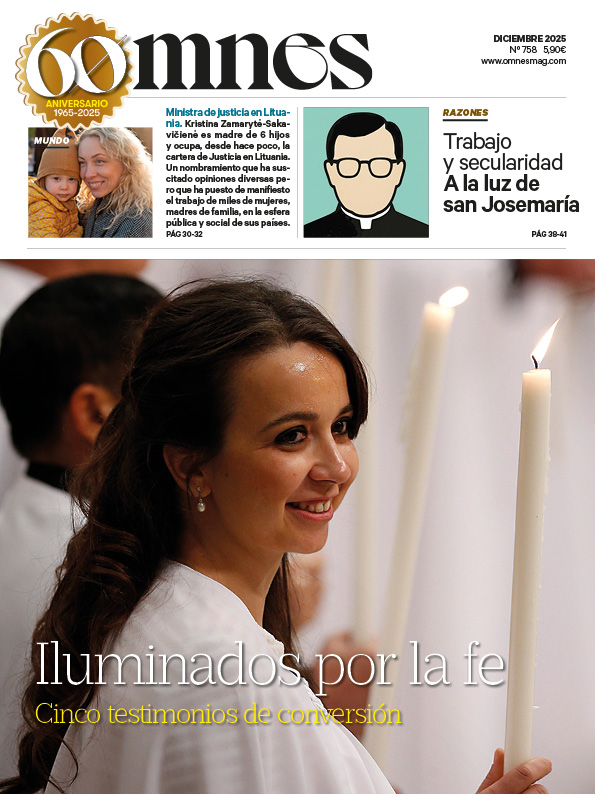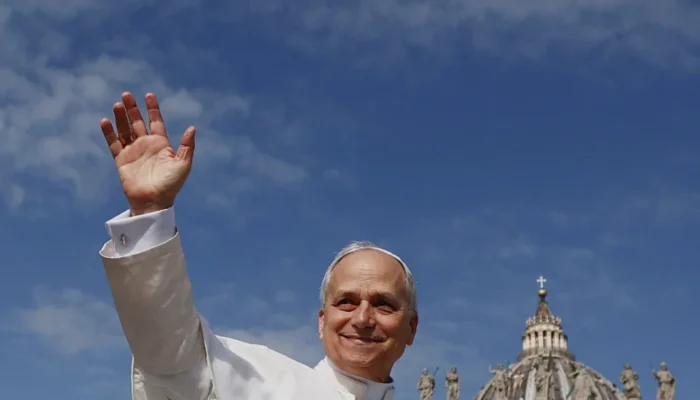The work begins with a few words of the saint from Barbastro that constitute the leit motif of the whole book: "Do not forget that liturgical life is a life of love; love of God the Father, through Jesus Christ in the Holy Spirit, with the whole Church, of which you are a part". Words that Bishop Mariano Fazio comments on in the prologue, saying: "This affirmation of the saint runs throughout the book, and as I have read it I have been able to see that the author has identified love as a key aspect in St. Josemaría's understanding of the liturgy.
Indeed, through the pages I have tried to show, with the life and teachings of St. Josemaría, often linked to biographical details, that the words with which the book begins are a reality. Love is a key point.
St. Josemaría and the liturgy
The fascination for the liturgy was manifested in him from a very young age, as I have tried to show throughout the first chapter. It marked his spiritual life and he remained faithful to it throughout his priestly ministry. Finding on October 2, 1928, the date on which he "saw" the Opus Deia transcendental milestone also in his life and liturgical teachings.
As can be seen in the three chapters, it can be said that from a liturgical logic I present his thought as the bearer of a particular richness coming both from the foundational charism received and from his contemplative life, as well as from the incidences of his priestly ministry.
I think we can say, without fear of being mistaken, that St. Josemaría was in love with the liturgy. This love, this entering into the Trinitarian current of love for mankind that is the Eucharist, led him throughout his life to seek always the best way to live, in the Church, that personal and loving encounter that is the Holy Mass. For this reason his preaching will be impregnated by liturgical sources. His life and teachings will seek to embody in the best possible way the very nature of the liturgy.
Vetus ordo
It was love for the liturgy that led him to "relate" to many of the intuitions of the liturgical movement in the 1930s. This same love for the liturgy, as an ecclesial reality, is what led him to promote an orderly and progressive introduction of the liturgical reform in the celebrations of the centers of Opus Dei, as requested by the Holy See. And it is his liturgical life, understood as an encounter of love with God, which allows us to understand that, after 45 years of seeking to make his own the words and gestures of the Tridentine Missal, he found it very difficult to change to the 1970 Missal and ended up benefiting, without having asked for it, from the indult that allowed him to continue celebrating in the last three years of his life with the rite prior to the conciliar reform.
Both in his published and unpublished writings, as well as in his oral preaching, it can also be seen that love is the center, the heart of his liturgical teachings.
Divine love
Divine love is poured out on the faithful through the Trinitarian current of love that is the Holy Mass and which awaits the response, also of love, from each Christian. A response which, united to Christ in his Church, they offer to the Father.
Divine love that awaits the correspondence of each person through this loving participation in the gestures and prayers of the Eucharistic celebration, thus showing the importance of exterior and interior participation in it, as St. Josemaría embodied in his mystagogical teachings and his life of liturgical love.
Love that characterizes the personal response and that goes beyond the ritual celebration, it involves life, as the saint teaches. In his preaching he clearly shows that all of us, as "priests of our own existence" through Baptism, manifest our love to the Father by returning to him the world transformed by Christ in the Holy Spirit, through that "Mass" that each one of us celebrates on the altar of our work, of our daily life. This "Mass" lasts twenty-four hours, and its center and root is the sacramental celebration.
Spanish liturgical movement
If we take a look at the structure of the book, we can see how it is projected in three concentric circles that converge in love: biographical, theological-liturgical and mystagogical notes. Throughout the pages of the first chapter, which is biographical in nature, we can see from the saint's published and unpublished writings, as well as from the testimonies of those who lived with him, how St. Josemaría in the 1930s was a true pioneer, a priest ahead of his time also in the liturgical field. In many of his liturgical decisions and experiences he appears to be related to the incipient Spanish liturgical movement, of which he knew several of its most important promoters and driving forces, who were his personal friends.
Basic aspects, such as the liturgy lived as a source of spiritual life and the concept of active participation, will be translated into concrete manifestations and decisions that the saint made and with which, in those years as a young priest, he sought to spread liturgical life: the dialogued Masses in the university residences that he promoted, the frequent communion, within the Mass and with consecrated hosts in the celebration itself as something habitual in his Mass and for all the people who participated in it, the use of ample vestments, as well as the indications for the construction of future oratories, are concrete and practical manifestations of that desire, as well as of his relationship with the ideas of the liturgical movement.
Liturgy and personal holiness
Throughout the pages of the second chapter, which is of a more theological nature, I have tried to show how the message that St. Josemaría Escrivá received on October 2, 1928, the universal call to holiness, is connected with the basilar ideas of the Council's teachings on the liturgy.
How can we fail to see in number 14 of the conciliar constitution Sacrosanctum Concilium In that famous issue we read: "Holy Mother Church ardently desires that all the faithful be led to that full, conscious and active participation in the liturgical celebrations which the nature of the Liturgy itself demands and to which the Christian people, 'a chosen race, a royal priesthood, a holy nation, a peculiar people' (1 Pet. 2:9; cf. 2:4-5), have a right and obligation by virtue of baptism" (1 Pet. 2:9).
The rediscovery of baptism and the consequent divine filiation, as the foundation of the universal call to sanctity, are directly related to this right and duty to participate in the liturgy. These are conciliar teachings that St. Josemaría had already anticipated in his mystagogical writings, as can be seen in the third chapter of the book, or in his own liturgical life and that of the members of the institution that God made him see, as can be seen in the first chapter, encouraging, for example, active participation in the residences that he promoted by living the so-called dialogued Masses.
The Mass, a Trinitarian action
At the same time, numbers 5 to 7 of the same conciliar constitution are also developed in the teachings of St. Josemaría. Thus the presentation of the Mass as an extension of the Trinitarian current of God's love for us, formulated by the saint, is related to the idea of the history of salvation rediscovered by St. Josemaría. Vatican Council IIThe fundamental component of love is emphasized.
The divine and Trinitarian character of the celebration of the Holy Mass, together with its Christological and ecclesial character, underlined by the saint, lead him to define the Eucharistic celebration as the center and root of Christian life. This expression is not only original in terms of the form or terms used, although we find it in a similar way in the magisterium of Pius XII, the Second Vatican Council and more generally in Catholic doctrine, but it receives a broader and more novel context in St. Josemaría.
The Mass, center and root
Indeed, the Holy Mass, presented as the center and root of the Christian life, connects with ordinary, ordinary life, the life of work, which is the place of encounter with God, as St. Josemaría had tirelessly preached since 1928. This secular life, this life in the world, a sanctifiable and sanctifying reality, finds its center and root in the celebration of the Eucharist. Therefore, every member of the faithful, by virtue of his or her baptism, as the Second Vatican Council would say, has the right and obligation to participate in liturgical celebrations, and the saint would proclaim it in a stronger and more emphatic way: each member of the faithful is a priest of his or her own existence. Hence the relationship between ordinary and working life and the Mass is intimate, intense, connatural to both realities. And therefore it is called to be prolonged in a Mass that lasts twenty-four hours.
If in the first chapter I tried to show how St. Josemaría was related to the liturgical movement, thus anticipating and preparing the ideas that would be taken up by the Second Vatican Council, in the second chapter I sought to show how the saint's teachings offer the Council's liturgical magisterium a context, a framework in which to live them. In fact, in his oral and written preaching he tirelessly proclaimed that every Christian, called to be a priest of his own existence by baptism, celebrates his twenty-four-hour Mass on the altar of his workplace and daily life, provided that the Eucharistic celebration is for him its center and root.
Liturgy is performative
Finally, in the third chapter I have tried to highlight St. Josemaría's keen awareness of the transforming power of the liturgy of the Holy Mass for the ordinary faithful. His teachings in this regard are many, and appear frequently in his writings. As the saint repeated: "I have always taught you to find the source of your piety in Holy Scripture and in the official prayer of the Church, in the Sacred Liturgy.
In this third chapter I have chosen to focus my attention especially on two texts: first, the homily "The Eucharist, Mystery of Faith and Love," in which, following the various parts of the Eucharistic celebration, St. Josemaría proposes consequences for the spiritual life of Christians. Secondly, I have made use of some commentaries on the Eucharistic celebration that our author was preparing in 1938 and which he intended to publish in a book entitled Liturgical devotions. In the second chapter of our book we have made a study of the project and of the cards that St. Josemaría had written during that year. In using them in our work we have reproduced them literally, that is, with the abbreviations, minor spelling mistakes, etc., that they contain.
Unpublished texts
These writings, dating from the end of the 1930s, seem to me to be a text of particular interest. Not only because of their unpublished character, but also because they show, in my opinion, how the saint read and knew the authors who presented commentaries on the Mass with a marked mystagogical aspect. At the same time, they show how he shared with them a way of understanding the liturgy that was totally advanced for his time, as can be seen, in part, thanks to the first chapter in which I have tried to show St. Josemaría's special relationship with the liturgical movement.
The commentaries are a perfect conjunction of liturgical history, ars celebrandiThe most characteristic of the saint are the considerations full of love, which are manifested in short phrases, sometimes only words - ejaculatory, darts - that seek to condense, in words, the love for the Mass that overflowed from his heart.
In turn, the combination of texts written in two different periods of the saint's life, the late thirties and the sixties with an ecumenical council and a liturgical reform in between, will show the continuity and harmony between the two, fruit, I believe, of our author's love for the liturgy.
The Mass explained by St. Josemaría
The commentary on the liturgy of the Holy Mass by St. Josemaría, which occupies the third chapter, seems to me to help us understand why the saint said: "By attending Holy Mass, you will learn to treat each of the divine Persons. In the celebration, the faithful can address the Father in Christ through the action of the Holy Spirit: in entering into dialogue with the divine Persons, their Christian life grows. It is a dialogue to which every gesture and word of the rite invites the faithful, and which thus takes on a special meaning.
In short, in the last chapter I tried to show that St. Josemaría was preparing to "speak" to the faithful about the Mass, not in a discursive way, but "mystagogically," that is, through the rites. It is logical that this should be so, since the extensive and profound reality of the spiritual effects of the Holy Mass should not run autonomously and independently of the texts and rites that mark the celebration of the Mass.
I would like to conclude with some words of the saint that seem to me to reflect very well all that I have tried to show in the book. It is a text written in 1931, which shows very well his formation and life for the liturgy and from the liturgy, love, divine filiation, the words and gestures of the liturgical celebration itself explain everything:
This morning I asked Jesus - I didn't ask Him, I mean wrong - I told Jesus of my desire to prepare myself very well, during Advent, for when the Child comes. I told Him many things, among them that He teach me to live the sacred Liturgy. I thought that my soul is a thirsty land and I was excited to read in the communio of the Holy Mass: Dominus dabit benignitatem, et terra nostra dabit fructum suum. Lord Jesus, may the poor wasteland of my soul, filled with your grace, bear fruit for eternal life. And I was confused, full of gratitude, when I recited the psalm in first place Confitemini Domino (Ps. 117)..., a faithful expression of what each one of those you have so far chosen for your Work could sing.








